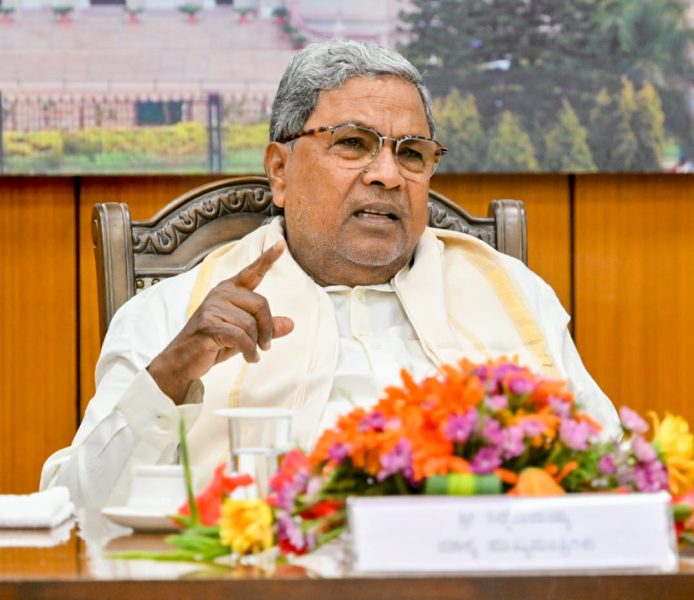
Karnataka govt budgets for 5 poll promises by squeezing the already taxed

Delivering on the five pre-poll guarantees, the Congress-led Karnataka government on Friday (July 7) announced an outlay of Rs 39,815 crore for the guarantees in the Budget.
The Shakti scheme of free rides for women in buses of the four public road transport corporations gets Rs 2,800 crore. It was launched on June 11. The full year’s outlay would have been Rs 4,000 crore. For an additional 5 kg of free cereals to below-poverty-level persons under the Annabhagya scheme, Rs 10,265 crore has been provided against
the estimated full-year cost of Rs 11,680 crore including expenditure on purchasing and distribution.
Gruha Jyothi – a scheme of free electricity up to 200 units per household per month – gets Rs 9,000 crore against the estimated 12-month cost of Rs 13,910 crore. Gruha Lakshmi or payment of Rs 2,000 a month to women heads of families has a provision of Rs 17,500 crore. This is Rs 12,500 cr less than the full-year cost. Yuvanidhi or payment of Rs 3,000 and Rs 1,500 a month respectively to those graduating or getting diplomas this year till they find employment (but capped at two years) has been provided Rs 250 crore. (The full year cost has not been disclosed in the budget).
The tab next year for four schemes, excluding Yuva Nidhi, will be Rs 57,910 crore.
Tax revenues
The Siddaramaiah government expects tax revenues to rise by Rs 32,000 crore, or 18 per cent from the revised estimate of last year. It expects the state’s economy to grow in the same proportion. This is lower than last year’s provisional GSDP growth estimate of 27 per cent over 2021-22. But that was on account of a post-Covid bounce.
Also read: Karnataka Budget highlights strains from BJP govt failures, Central aid shortcomings
The five poll promises will consume 23 per cent of the state’s own tax revenue. Plus, there are other subsidies – on milk and concessional supply of electricity to farmers – which eat up another 26 per cent of own tax revenue.
Since the government has avenues of raising revenue, it is squeezing more from the same, highly taxed sources. Those drinking beer and spirits will pay Rs 36,000 crore in state excise – up 12.5 per cent over the revised estimate of last year. Whisky brands, for instance, cost double the Delhi rates, but the Chief Minister, who doubles up as the Finance Minister, said they would be still be cheaper than in some of the neighbouring states.
Stamp and registration fee on property will fetch Rs 25,000 crore, up Rs 8,000 crore or 47 per cent more than the revised estimate. Taxes on sales and trade, mainly on motor fuels, will yield Rs 21,100 crore, or 11 per cent more than last year. Vehicles will be taxed 28 per cent more. These four heads alone will contribute about 43 per cent of the cost of the five promises.
The duty on electricity is expected to fetch Rs 775 crore less, because of free supply to the poor. The revenue deficit will double to Rs 12,523 crore. It will be 0.49 per cent of the state’s GSDP – up from 0.27 per cent last year.
Revenue vs expenditure
While redeeming the promises, Siddaramaiah said they would improve the monthly household budgets of the beneficiaries by about Rs 4,000 a month or Rs 48,000 a year. He said this was an inflation-mitigating measure and the first initiative in the country to provide universal basic income to citizens.
But total revenue expenditure is estimated to rise by lower than the cost of the five poll promises, suggesting that allocations have been cut elsewhere. Capital expenditure has been reduced by Rs 1,765 crore.
The capital outlay for the four public road transport corporations is Rs 873 crore against Rs 1,402 crore last year. But last year’s figure included Rs 811 crore of unpaid motor vehicles tax converted into government equity. These corporations had piled up losses of Rs 5,555.64 crore at the end of March 2022. (This figure is short by a corporation’s 2021–22 loss). The government owed them Rs 4,265 crore in 2020–21 for concessions to the public as per a CAG report. With the government providing for the Shakti scheme in the budget, hopefully, they will be paid in time for free bus rides to women passengers and they will not have to borrow.
Also read: Karnataka Budget: CM Siddaramaiah says Rs 52,000 cr to be spent for 5 key poll promises
Women seem to be enthusiastic about free bus rides. The Chief Minister said 130 million tickets were issued in the first 13 days of launch of the Shakti scheme. That is about 50–60 lakh daily commutes by women. If the trend continues, the outlay for the scheme will have to be higher as the transport department had estimated the cost of Rs 4,000 a year on the assumption that 42 lakh women will be travelling per day.
There are those like this writer who feel that there should be a distance limit as in Tamil Nadu or Delhi, where women can travel free in state buses. But the Chief Minister said Shakti was meant to enable them to “take up employment in distant places” and not just a little distance away from their homes. If intra-state migration for work is to be enabled, then there should be no travel restrictions.
Geography is indeed destiny and physical mobility is essential for upward mobility. But the devil lies in the details.
Hopefully, these concessions will enhance the purchasing power of those at the bottom and increased consumption will drive overall economic activity.


